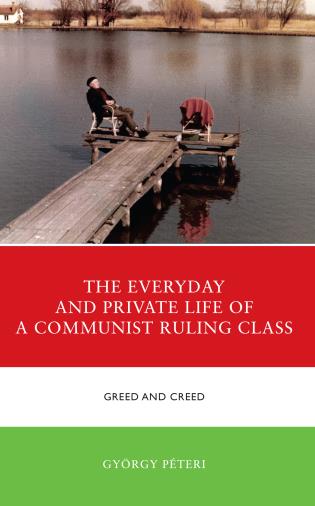The consumerism of “real” socialism
 Fortepan / FŐFOTÓ
Fortepan / FŐFOTÓ 
Published by: Rowman & Littlefield
 Fortepan / FŐFOTÓ
Fortepan / FŐFOTÓ This important, path-breaking and meticulously researched book is about socialist consumerism or, more accurately, the consumerism of “actually existing” or “real” socialism, which had very little socialist about it, being a “pathetic imitation” of western consumer society, a phrase coined by the Hungarian historian Iván T. Berend which Péteri frequently cites. Communist modernization could have been different. Péteri uses the example of Khrushchev’s (never-achieved) automobilism policy based on collective pools of rental cars and taxis. The thrust of Péteri’s book is to show both how and, more importantly, why this socialist alternative was a non-starter: the decision in favor of individualized consumption became inevitable as members of the party apparatus, “acquisitive functionaries”, overcame the spirit of the “new sobriety” to achieve their group interests.
The book’s six chapters address the question in a variety of ways. Chapter one introduces the consumerism theme by arguing that the study of everyday life is the study of consumerism, which in the socialist case requires focusing on shortage rather than abundance. Péteri insists that post-1956 Hungary was indeed characterized by consumerism even though economic reformers failed to achieve the supply-side abundance that the reform economist Péter György had called for in the 1950s. Eastern Europe from the 1960s onwards in fact experienced “demand-side abundance”: consumerist desires within an economy of shortage. The rest of the chapter investigates this contradiction in two very different ways: first, by examining the ambiguities that “refrigerator socialism” inspired through cartoons on the pages of the satirical magazine Ludas Matyi; and, second, by presenting the last-gasp theoretical attempt to rescue alternative socialist values in the contributions of the critical sociologists András Hegedüs and Mária Márkus to the Committee for Long-Term Planning of Labor Force and Living Standards in 1968-1969. Chapter two then presents the academically unacknowledged “new sobriety” that János Kádár sought to introduce after 1956 to distinguish his regime from the excesses of Stalinism, excesses satirically depicted by Gyula Háy in his fictional creation Comrade Kucsera.
Chapter three turns to the “acquisitive functionary.” First, Péteri presents cases of the abuse of power (in housing allocation and house furnishings) as identified by the Central Commission of Control. The guilty parties were initially reprimanded but, for the most part, subsequently saw their reprimands expunged. Second, he addresses Khrushchev’s automobilism plan, identifying its abandonment and the dramatic increase in the number of private cars, especially in the 1970s. The chapter concludes by analyzing the film “Don’t waste the gas!”, notionally critical of private motoring but with an ambiguous ending suggesting complicity between the viewing public and the apparatus class.
each hunter had a quota of 60 kilograms of big game per year for personal use; the Szeged Salami Factory would even convert this to sausages or salamis at attractive prices.
In the fourth chapter, Péteri turns to hunting, the absorbing passion of much of the elite of socialist society. He begins with the World Exhibition of Hunting held in Budapest in 1971, an initiative of Hungary’s influential “agrarian lobby” which was attended by, among other western dignitaries, the then Duke of Edinburgh, husband of Queen Elizabeth II. By marketing Hungarian hunting to the west, the organizers sought to defray in part the costs of subsidized rest and recuperation for those at the very top. The chapter is full of photographs of hunting parties and statistics on hunting, together with details of the Concord Hunting Club to which the top elite belonged. A telling figure is that the members of the politburo in the Concord club hunted on average 43 days per year, more than their official paid vacation. Membership fees were nominal, and each hunter had a quota of 60 kilograms of big game per year for personal use; the Szeged Salami Factory would even convert this to sausages or salamis at attractive prices.
Chapters five and six are the most important for the overall argument of the book. Prior to these chapters, we have only been introduced to the unequal rewards enjoyed by the party apparatus in the luxury retreats of the hunting lodge and when using influence to create an approximation of luxurious housing. In the final two chapters, we see party functionaries influencing national policy to serve their private interests, in relation to holidays (chapter five) and motoring (chapter six). In chapter five the issue is retaining privileged access to holiday resorts after Kádár’s “new sobriety” handed most over to the national trade union body, treating apparatchiks not much better than ordinary workers. Within a year the party center was backing down in the face of outrage within the ranks as reference to “modesty” disappeared from official documents. But the big political struggle came in 1962-1963. Péteri goes into labyrinthine detail describing the machinations of the politburo, the Ministry of Labor Affairs and the trade unions. The writing is dense, but worth the effort, because it is a rare example of how the interests of a specific group could win through, and against Kádár’s personal wishes, within a bureaucracy that is traditionally depicted as totalitarian.
Chapter six presents the party center’s various unsuccessful attempts, in the face of obstructionism, to impose limits on the personal use of official cars, including an almost Khrushchevian “taxi system.” The issue was ultimately resolved to everyone’s satisfaction in 1972 by the center changing tack and facilitating and subsidizing the private purchase of cars by party-state apparatchiks. It was the self-interested activism of these privileged members of society, rather than a decision of principle taken at the top, that explains Hungary’s drift to a “pathetic imitation” of western consumerism.
Péteri acknowledges that the book took fifteen years to write, and this is reflected in some inconsistences of usage (Trotskii and Trotsky) and minor repetition. Those with a background in the UK labor movement would insist on “vanguard” rather than “avant-garde” for the Marxist-Leninist party, while the occasional Hungarianism remains. This reviewer was also puzzled by the determining role that the author gives to “demand-side abundance” yet his insistence in the Conclusion that Hungary was just another semi-periphery economy. One does not have to be an apologist for Erich Honecker to take the view that 90 percent state ownership of the economy under “real socialism” imposed a specific set of constraints.
Nigel Swain is Honorary Senior Research Fellow in the Department of History at the University of Liverpool where he taught for over two and a half decades. His main academic research addresses the impacts of collectivisation and decollectivisation on rural labour and rural communities in socialist and post-socialist Eastern Europe, with a focus on Hungary. Beyond the rural sphere, he has published on Hungary’s model of “feasible socialism”, the politics of Hungary’s round table negotiations in 1989, conflicting narratives of victimhood surrounding Hungary’s Status Law of 2001 and the political, social and economic history of Eastern Europe from 1945 to EU accession.

The Everyday and Private Life of a Communist Ruling Class: Greed and Creed
Published by: Rowman & Littlefield
